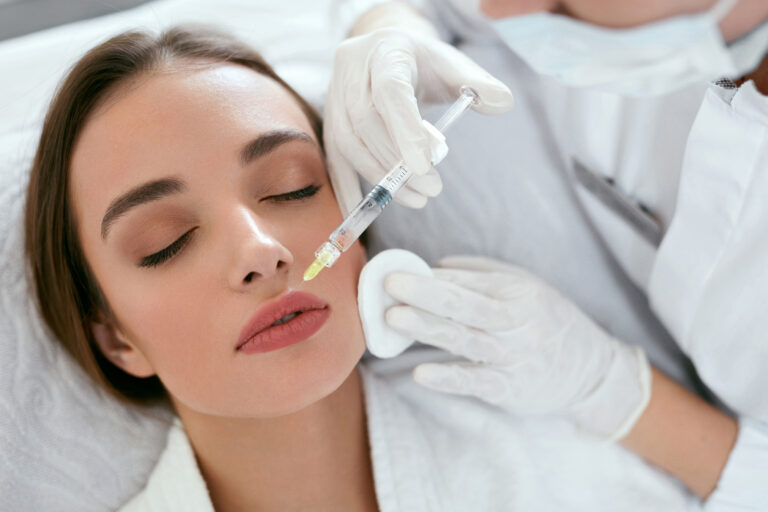Everything You Need To Know About Lip Filler
Lip Filler History
Lip fillers are a cosmetic procedure that involves injecting a substance into the lips to add volume, shape, and definition. The popularity of lip fillers has been on the rise in recent years, thanks in part to celebrities and influencers who have made fuller lips a sought-after feature. The use of lip fillers has become more accessible and affordable, making it a popular cosmetic option for those looking to enhance their appearance.
The history of lip fillers dates to the early 1900s when paraffin wax was used as a filler for the lips. However, this method had serious drawbacks, including the risk of infection and inflammation. In the 1980s, collagen was introduced as a more effective and safer option for lip fillers. In recent years, hyaluronic acid (HA) has become the most popular substance for lip fillers due to its natural-looking results and low risk of complications. Today, lip fillers are a common and popular cosmetic procedure, with thousands of people opting for the treatment each year.
What is Lip Filler?
Lip fillers are cosmetic injectable treatments that are designed to enhance the appearance of the lips by adding volume, shape, and definition. The purpose of lip fillers is to create a fuller and more youthful appearance to the lips, as well as to improve symmetry and proportion between the upper and lower lips. Lip fillers can also help to smooth out fine lines and wrinkles around the mouth, giving a more youthful appearance.
There are several types of lip fillers available, but the most common types are those made from hyaluronic acid (HA). Hyaluronic acid is a naturally occurring substance in the body that helps to hydrate and plump the skin. When used as a lip filler, HA adds volume to the lips, improves definition, and smooths out fine lines and wrinkles. Other types of lip fillers include those made from collagen, fat grafting, and synthetic substances.
The way lip fillers work is by injecting a substance into the lips, which adds volume and shape. The procedure is typically done using a small needle, and the amount of filler used is determined by the patient’s desired outcome. The effects of lip fillers typically last anywhere from six months to a year, depending on the type of filler used, the amount injected, and the individual’s metabolism. Over time, the body naturally metabolizes the filler, and the effects gradually wear off.
Lip Filler Benefits
There are several benefits to getting lip fillers. Here are some of the main benefits:
- Enhanced appearance of lips: One of the most obvious benefits of lip fillers is that they enhance the appearance of the lips. The added volume and definition can create a more aesthetically pleasing look, giving the lips a fuller and more symmetrical appearance.
- Boost of self-confidence: Having fuller and more defined lips can boost a person’s self-confidence and self-esteem. It can make them feel more attractive and comfortable in their own skin, which can have a positive impact on their overall quality of life.
- Youthful look: As we age, our lips tend to lose volume and definition. Lip fillers can help to reverse this process, creating a more youthful appearance to the lips.
- Natural-looking results: When done properly, lip fillers can provide natural-looking results that enhance the natural beauty of the lips. With advances in technology and techniques, it is possible to achieve a subtle and natural look that is tailored to the individual’s desired outcome.
Risks & Side Effects
While lip fillers are generally considered safe, there are some potential risks and side effects that patients should be aware of. Here are some of the most common risks and side effects of lip fillers:
- Swelling, bruising, and discomfort: It is common to experience some degree of swelling, bruising, and discomfort after getting lip fillers. This usually resolves within a few days, but it can take up to two weeks for the swelling to fully subside.
- Allergic reactions: Some patients may have an allergic reaction to the filler material. Symptoms of an allergic reaction can include swelling, redness, itching, and hives.
- Infection and scarring: There is a small risk of infection and scarring with any injectable procedure. To minimize this risk, it is important to choose a reputable provider and follow all aftercare instructions.
- Migration and lumps: In some cases, the filler material may migrate away from the injection site or clump together, creating visible lumps or bumps.
- Hematomas: A hematoma is a collection of blood under the skin. While rare, hematomas can occur after lip filler injections.
- Necrosis: Necrosis is a rare but serious complication that occurs when the filler material blocks blood flow to the tissues. This can result in tissue death and scarring.
It is important to discuss any potential risks and side effects with your provider before getting lip fillers. Be sure to choose a reputable provider who has experience performing lip filler injections and who can provide you with a thorough consultation and aftercare instructions.
Choosing a provider for lip fillers
Choosing a qualified provider for lip fillers is crucial to ensuring a safe and successful procedure. Here are some tips for choosing a provider for lip fillers:
- Look for a qualified provider: It is important to choose a provider who is qualified to perform the procedure. This means that they should be licensed medical professionals, such as a physician or nurse practitioner, who has received specialized training in injectables.
- Ask about experience: Experience is key when it comes to getting lip fillers. Ask your provider how many lip filler procedures they have performed and if they have experience with the specific type of filler you are considering.
- Check for certifications: Look for a provider who is certified by a reputable organization, such as the American Society for Aesthetic Plastic Surgery (ASAPS) or the American Society for Dermatologic Surgery (ASDS).
- Ask for before-and-after photos: Before-and-after photos can give you a good idea of what kind of results you can expect from the provider.
- Ask about the procedure: Ask your provider about the specific type of filler they will be using, the amount of filler needed to achieve your desired result, and what kind of aftercare is required.
- Read reviews and ask for recommendations: Look for reviews from previous patients and ask friends or family members for recommendations.
- Trust your instincts: Ultimately, it is important to choose a provider that you feel comfortable with and who you trust to perform the procedure safely and effectively.
Remember that lip fillers are a medical procedure, and it is important to take the time to research and choose a qualified provider. By doing your due diligence, you can help ensure a safe and successful outcome.
Preparing for Lip Filler
Preparing lip fillers can help to ensure a smooth and successful procedure. Here are some tips for preparing for lip fillers:
- Consultation with provider: Before getting lip fillers, it is important to have a consultation with your provider. This will give you the opportunity to discuss your goals, ask any questions you may have, and ensure that you are a good candidate for the procedure.
- Avoiding certain medications and supplements: Some medications and supplements can increase the risk of bleeding and bruising. It is important to avoid these for at least two weeks before your procedure. Your provider will provide you with a list of medications and supplements to avoid.
- Drinking plenty of water: Staying hydrated can help to minimize swelling and bruising after the procedure. Be sure to drink plenty of water in the days leading up to your appointment.
- Preparing for recovery: Recovery from lip fillers typically involves some degree of swelling and bruising. It is important to prepare for this by arranging for time off work or other responsibilities, stocking up on ice packs and pain relievers, and avoiding strenuous activity for at least 24 hours after the procedure.
- Following all instructions from your provider: Your provider will provide you with specific instructions for before and after your lip filler procedure. It is important to follow these instructions closely to ensure the best possible outcome.
By taking these steps to prepare for your lip filler procedure, you can help to ensure a safe and successful outcome.
Lip Filler Procedure
The lip filler injection procedure typically involves the following steps:
- Preparation: Before the procedure begins, the provider will clean the injection site and may apply a numbing cream or local anesthesia to minimize discomfort.
- Injection: Once the area is numb, the provider will use a small needle to inject the filler into the lips. The amount of filler used will depend on the individual’s goals and the desired outcome.
- Massage: After the filler has been injected, the provider may massage the lips to help distribute the filler and ensure a smooth, even result.
- Evaluation: Once the procedure is complete, the provider will evaluate the results and make any necessary adjustments.
The lip filler injection procedure typically takes about 15 to 30 minutes to complete. Most patients experience minimal discomfort during the procedure, thanks to the use of local anesthesia and numbing agents.
The technique used for lip filler injection can vary depending on the provider’s preference and the specific filler being used. However, some common injection techniques include the linear threading technique, the fanning technique, and the microdroplet technique.
Before and after photos can be a helpful tool for both the provider and the patient to evaluate the results of the procedure. Providers will often take before-and-after photos to track the progress of the treatment and ensure that the patient is happy with the outcome. Patients may also be asked to provide consent for their photos to be used for marketing or educational purposes.
Recovery & Aftercare
Recovery and aftercare for lip fillers are important to ensure a safe and successful outcome. Here are some tips to help manage swelling and bruising, avoid certain activities, and promote a quick recovery:
- Managing swelling and bruising: Swelling and bruising are common after lip filler injections. To help manage these symptoms, apply ice packs to the lips for 10 to 15 minutes at a time, several times a day. Avoid heat, alcohol, and salty foods, which can increase swelling.
- Avoiding certain activities: To ensure a quick recovery, it is important to avoid certain activities after lip filler injections. These may include strenuous exercise, facial massages, and saunas or hot tubs for at least 24 hours after the procedure.
- Recommended aftercare products: Your provider may recommend certain aftercare products to help promote healing and minimize swelling and bruising. These may include arnica gel or supplements, which can help to reduce bruising, and lip balm or ointment to keep the lips moisturized.
- Tips for quick and safe recovery: In addition to the above tips, it is important to take care of your overall health to promote a quick and safe recovery. This may include getting plenty of rest, staying hydrated, and avoiding smoking, which can slow down the healing process.
It is important to follow all instructions from your provider and to schedule a follow-up appointment to ensure that your lip fillers are healing properly. If you experience any unusual symptoms or complications, such as excessive swelling, bleeding, or pain, contact your provider right away.
How Long Does It Last?
The longevity of lip fillers can vary depending on several factors, including the type of filler used, the individual’s metabolism, and the area injected. Generally, lip fillers can last anywhere from 6 months to 2 years.
Factors that affect the longevity of lip fillers include:
- Type of filler: Some types of fillers, such as hyaluronic acid fillers, tend to last longer than others.
- Individual metabolism: The rate at which the body metabolizes the filler can affect how long it lasts.
- Injection site: The lips are a highly mobile area of the face, and fillers may break down faster in this area than in other areas.
Touch-up and maintenance appointments can help to maintain the results of lip fillers. Your provider may recommend scheduling touch-up appointments every 6 to 12 months, depending on the type of filler used and the individual’s goals.
It is important to schedule a follow-up appointment with your provider after the initial injection to ensure that the results are satisfactory and to address any concerns or complications. Additionally, if you experience any unusual symptoms or changes in the appearance of your lips, such as asymmetry or lumps, you should contact your provider right away.
Final Thoughts
In conclusion, lip fillers are a popular cosmetic procedure used to enhance the appearance of the lips, boost self-confidence, and achieve a more youthful look. Choosing a qualified provider and preparing correctly for the procedure is essential to ensure a safe and successful outcome.
Although lip fillers are generally safe, there are potential risks and side effects to consider, such as swelling, bruising, and infection. Proper aftercare and follow-up appointments can help manage these risks and maintain the procedure results.
The longevity of lip fillers can vary depending on several factors, and touch-up appointments may be necessary to maintain the desired results.
If you are considering lip fillers, it is essential to do your research, ask questions, and discuss your goals and concerns with a qualified provider. With proper preparation and care, lip fillers can help you achieve the desired look and boost your confidence.



